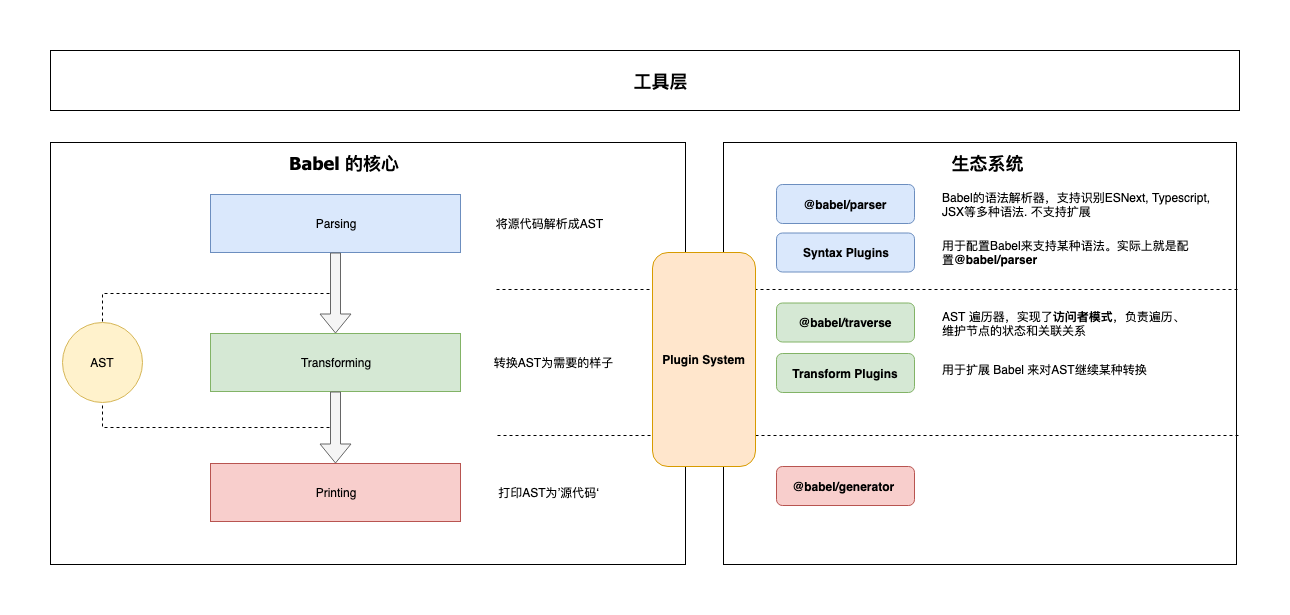“Yeah It’s on. ”
正文
https://juejin.im/post/5b9dbd7a5188255c6a042b71
babel工作的原理

Babel对代码进行转换,会将JS代码转换为AST抽象语法树(解析),对树进行静态分析(转换),然后再将语法树转换为JS代码(生成)。每一层树被称为节点。每一层节点都会有type属性,用来描述节点的类型。其他属性用来进一步描述节点的类型。
// 将代码生成对应的抽象语法树
// 代码
const result = 1 + 1
// 代码生成的AST
{
"type": "Program",
"start": 0,
"end": 20,
"body": [
{
"type": "VariableDeclaration",
"start": 0,
"end": 20,
"declarations": [
{
"type": "VariableDeclarator",
"start": 6,
"end": 20,
"id": {
"type": "Identifier",
"start": 6,
"end": 12,
"name": "result"
},
"init": {
"type": "BinaryExpression",
"start": 15,
"end": 20,
"left": {
"type": "Literal",
"start": 15,
"end": 16,
"value": 1,
"raw": "1"
},
"operator": "+",
"right": {
"type": "Literal",
"start": 19,
"end": 20,
"value": 1,
"raw": "1"
}
}
}
],
"kind": "const"
}
],
"sourceType": "module"
}
astexplorer
一个简单plugin例子:
https://astexplorer.net/#/gist/c103ecf502c10b6d9e5ab69df5580a55/fc6e168a7f32738fb6bb2e0b55c5ea1ad17830fd
基础知识
https://juejin.im/post/5d94bfbf5188256db95589be
@babel/core
‘微内核’架构中的‘内核’。对于Babel来说,这个内核主要干这些事情:
- 加载和处理配置(config)
- 加载插件
- 调用
Parser进行语法解析,生成AST - 调用
Traverser遍历AST,并使用访问者模式应用’插件’对 AST 进行转换 - 生成代码,包括SourceMap转换和源代码生成
预设(Presets)
https://www.babeljs.cn/docs/presets
不想自己动手组合插件?没问题!preset 可以作为 Babel 插件的组合,甚至可以作为可以共享的 options 配置。
我们已经针对常用环境编写了一些 preset:
- @babel/preset-env
- @babel/preset-flow
- @babel/preset-react
- @babel/preset-typescript
遍历
AST是树形的结构, AST的转换的步骤就是通过访问者对AST的遍历实现的。访问者会定义处理不同的节点类型的方法。遍历树形结构的同时,, 遇到对应的节点类型会执行相对应的方法。
访问者
Visitors访问者本身就是一个对象,对象上不同的属性, 对应着不同的AST节点类型。例如,AST拥有BinaryExpression(二元表达式)类型的节点, 如果在访问者上定义BinaryExpression属性名的方法, 则这个方法在遇到BinaryExpression类型的节点, 就会执行, BinaryExpression方法的参数则是该节点的路径。注意对每一个节点的遍历会执行两次, 进入节点一次, 退出节点一次
const visitors = {
enter (path) {
// 进入该节点
},
exit (path) {
// 退出该节点
}
}
路径
每一个节点都拥有自身的路径对象(访问者的参数, 就是该节点的路径对象), 路径对象上定义了不同的属性和方法。例如: path.node代表了该节点的子节点, path.parent则代表了该节点的父节点。path.replaceWithMultiple方法则定义的是替换该节点的方法。
节点的路径信息, 存在于访问者的参数中, 访问者的默认的参数就是节点的路径对象
替换节点
替换一个节点
BinaryExpression(path) {
path.replaceWith(
t.binaryExpression("**", path.node.left, t.numberLiteral(2))
);
}
用多节点替换单节点
ReturnStatement(path) {
path.replaceWithMultiple([
t.expressionStatement(t.stringLiteral("Is this the real life?")),
t.expressionStatement(t.stringLiteral("Is this just fantasy?")),
t.expressionStatement(t.stringLiteral("(Enjoy singing the rest of the song in your head)")),
]);
}
停止遍历
如果你的插件需要在某种情况下不运行,最简单的做法是尽早写回,但是这里还是会进行下一个的BinaryExpression的遍历。
BinaryExpression(path) {
if (path.node.operator !== '**') return;
}
如何做到直接停止遍历?
利用path.stop()
const visitor = {
FunctionDeclaration(path, state) {
console.log("1111")
path.stop()
},
}
这里只会输出一次 1111
插件
插件选项
如果您想让您的用户自定义您的Babel插件的行为您可以接受用户可以指定的插件特定选项,如下所示:
{
plugins: [
["my-plugin", {
"option1": true,
"option2": false
}]
]
}
这些选项会通过状态对象传递给插件访问者:
export default function({ types: t }) {
return {
visitor: {
FunctionDeclaration(path, state) {
console.log(state.opts);
// { option1: true, option2: false }
}
}
}
}
这些选项是特定于插件的,您不能访问其他插件中的选项。
插件之前或之后函数
插件可以具有在插件之前或之后运行的函数。它们可以用于设置或清理/分析目的。
export default function({ types: t }) {
return {
pre(state) {
this.cache = new Map();
},
visitor: {
StringLiteral(path) {
this.cache.set(path.node.value, 1);
}
},
post(state) {
console.log(this.cache);
}
};
}
插件顺序
插件的排列顺序很重要。
这意味着如果两个转换插件都将处理“程序(Program)”的某个代码片段,则将根据转换插件或 preset 的排列顺序依次执行。
- 插件在 Presets 前运行。
- 插件顺序从前往后排列。
- preset 顺序是颠倒的(从后往前)。
例子:
{
"plugins": ["transform-decorators-legacy", "transform-class-properties"]
}
先执行 transform-decorators-legacy ,在执行 transform-class-properties。
重要的时,preset 的顺序是 颠倒的。如下设置:
{
"presets": ["es2015", "react", "stage-2"]
}
将按如下顺序执行:stage-2、react 然后是 es2015。
这主要的是为了确保向后兼容,因为大多数用户将 “es2015” 排在 “stage-0” 之前。有关详细信息,请参阅 notes on potential traversal API changes。
遇到的问题
获取当前文件的文件名
http://cn.voidcc.com/question/p-aqzjwhiv-gx.html
我正在尝试为babel编写一个插件,如何可以拿到当前文件的文件名?
export default function({ types: t }) {
return {
visitor: {
Identifier(path) {
// something here??
}
}
};
}
方法一:
console.log("this", this.filename)
方法二:
Identifier(path, state) {
console.log(state.file.opts.filename);
}
Maximum call stack size exceeded while using path.replaceWith
当使用path.replaceWith的时候一定要注意,是否用了相同节点替换了节点
例子:
FunctionDeclaration(path, state) {
// .....
// 这种情况会导致不断重复FunctionDeclaration
path.replaceWith(t.functionDeclaration(t.identifier("aaa"), [], ...))
}
报错: the program crashed with Maximum call stack size exceeded
函数
函数分为4种情况:函数声明 、箭头函数 、函数表达式 、函数为对象的方法
FunctionDeclaration 函数声明 声明一个函数,例如 function
FunctionExpression 函数表达式 例如const func = function () {}
ObjectMethod 对象中定义的方法 例如 let obj = { fn () {} }
ArrowFunctionExpression 箭头函数表达式 例如const func = ()=> {}